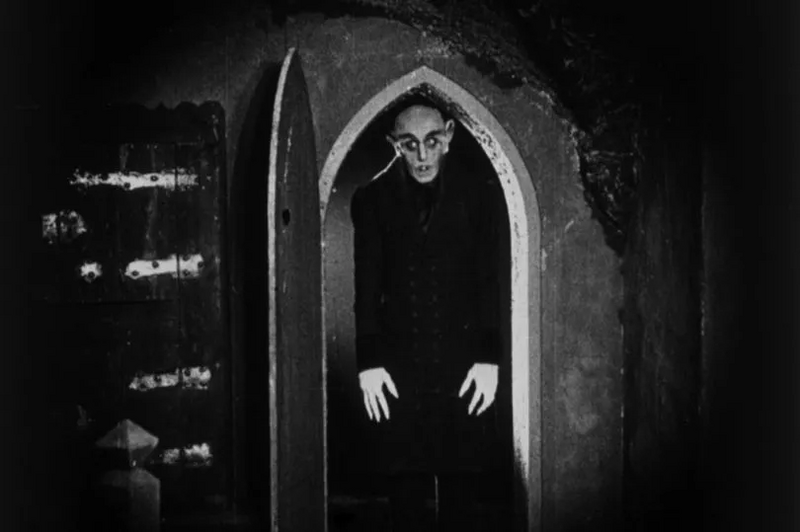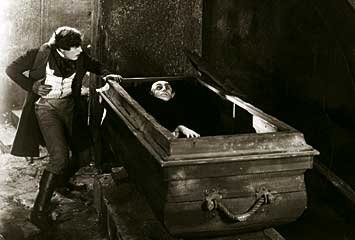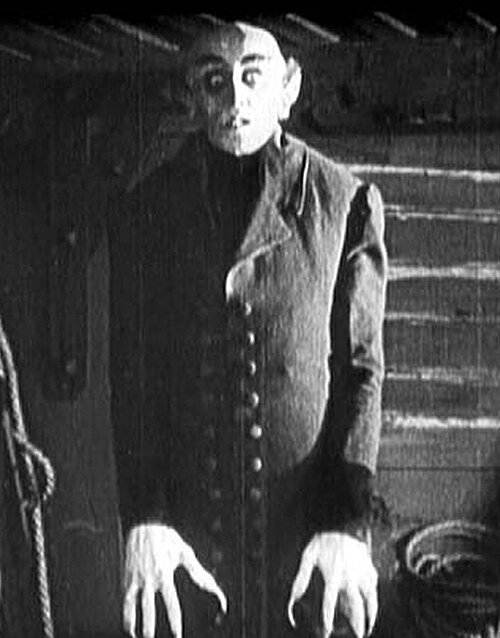
Nosferatu, a Symphony of Horror (O.V. “Nosferatu, eine Symphonie des Grauens”)
Germany, 1922
Director: Friedrich Wilhelm Murnau
Script: Henrik Galeen
Main actors:Max Schreck, Gustav von Wangenheim, Greta Schröder, Alexander Granach
Genre: Horror
Plot
1838. Young Hutter, happily married to Ellen, works for a real estate agency in the German town of Wisborg. Knock, the owner of the agency, receives a letter from Transylvania. Count Orlok informs him (in strange hieroglyphics) that he wishes to buy a property in Wisborg. Knock is a somewhat sinister individual, who seems to be versed in the occult arts. He instructs his employee Hutter to meet the Count in Transylvania to sign the contract. In the meantime, Ellen will live with Harding and his sister, friends of the couple.
Once in the Carpathian Mountains, the locals react in terror when Hutter nonchalantly mentions in an inn that he is going to Orlok Castle. In his room at that inn, the real estate clerk finds a little book about vampires, specifically about the “Nosferatu,” which according to local beliefs is “the son of Belial.” Hutter scoffs at these legends, believing them to be nothing more than absurd superstitions…
The next day he arrives at the count’s castle, somewhat late, as those driving the horse-drawn carriage refused to continue on from a certain place for fear of Orlok. Hutter continues on foot, arriving around midnight.
Once there, the young man will discover with uneasiness that perhaps there was some truth in the panic and aversion that the inhabitants of the region felt towards the count.
And he will be convinced of this when Orlok embarks for the West, becoming a threat to his people in general and to his wife Ellen in particular…

Commentary
This is the first film version of the well-known story of Dracula, written by Bram Stoker. Although director Murnau changed the names of the characters, the plot is practically the same. As a result, Murnau and the producers of this expressionist feature film would have serious legal problems concerning copyrights. The widow of the Irish writer denounced them for plagiarism and exploitation of other people’s ideas, and even demanded that all copies of the film be destroyed. Fortunately this did not happen. So today we can enjoy, more than 100 years later, one of the most emblematic cinematographic works of silent films and horror films in general.
Nosferatu’s passage from his castle in the Carpathian Mountains to Wisborg leaves a trail of death that is classified as an epidemic. A mysterious disease, which seems to be highly contagious, affects sailors and anyone who gets too close to those boxes transported by the ship “Empusa” (incidentally, that name refers to a vampiric-succubic creature from Greek mythology). Those boxes are coffins containing the living dead, the earth in which he was buried, and his escorts: a legion of rats (symbol of the contagion of the plague).
In addition to rats, mosquitoes (which bite Hutter while he is writing the letter to his wife) also play a certain role and are more than likely a metamorphosis of the vampire himself (who is not only capable of becoming a bat).
This pandemic coming from the East and caused by the “bat” (the vampire) has its origin in a parasitic aristocrat, called Count Orlok; who settles in Western Europe because he is no longer satisfied with being a bloodsucker only in Transylvania. But the Westerners, very rationalists themselves, do not believe in old wives’ tales and absurd legends of villagers (today they would be called “conspiracy theories”). Only the vampire’s servants, like Knock (who ends up going mad), know who this dismal count really is and what he does with his free time. Knock will become a scapegoat for the irate Germans of Wisborg, who will end up taking the pandemic seriously even if they are not very clear about its real origins. When things get serious and the plague spreads, a town crier will be announcing through the streets that a confinement has been decreed for the population, and that everyone must keep the quarantine at home.

To defeat the vampire (capable, by the way, of exercising mind control at a distance) requires the sacrifice of a “pure maiden”. And the only thing that can neutralize the sinister spawn is the light of the Sun (because when lies, evil and falsehood are exposed to the Light, to the Truth; that lie loses all its power, is destroyed by itself and is reduced to ashes).
Somewhat anecdotally, Professor Bulwer, a Paracelsus scholar, intervenes. Bulwer is an expert scientist in spiritual and metaphysical matters (today we would consider him an exponent of holistic medicine). Bulwer’s name is probably a reference to the English occultist writer Edward Bulwer-Lytton, author among other books of “The Future Race” or “Zanoni”.
Both the screenwriter Henrik Galeen and the producer Albin Grau (who was a member of the Fraternitas Saturni), had contact with the “O.T.O.” (“Ordo Templi Orientis”), Aleister Crowley’s secret society.
Galeen would later direct the highly recommended “Alraune” (1928) where the creation of artificial life is thematized. Grau was the co-founder of the film studio Prana-Film, so named in honor of the oriental (Hindu-Buddhist) concept of prana (vital energy, the one on which vampires feed parasitically). Prana-Film had as its logo the Yin and Yang, symbol of polarity and eternal flow. The company filed for bankruptcy to avoid lawsuits from Stoker’s widow, so this “Nosferatu” was his only film.
Nosferatu’s impressive and terrifying appearance has deservedly gone down in film history: long and scrawny, emaciated, bald, with bushy eyebrows, an aquiline nose and pointed ears, as well as enormous fingernails that look more like claws. The actor Max Schreck characterized the character in this way (by the way, “Schreck” means “fright” in German).
Wisborg, the northern German coastal town where most of the film is set, is a fictional location.
Later, with the films of the following decades, the aesthetics of Bela Lugosi or Christopher Lee would be imposed, who embodied a vampire also sinister but more human (and even handsome), bequeathing us the classic look of Dracula known to all.
Among the cryptic hieroglyphs of the count’s letter there is also a swastika, in addition to the planetary symbols. It is supposed to be written in Enochian, a mystical language created by the occultist John Dee, who claimed to communicate with entities from other planes in this way.
Get Nosferatu HERE!
(This is an affiliate link. I may earn a commission if you purchase through these link, at no extra cost to you. As an Amazon Associate, I earn from qualifying purchases.)
